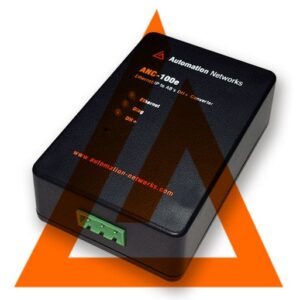Automation Networks ANC Ethernet/IP Converter Series
Automation Networks has many Ethernet/IP ANC Converter Gateways solutions to various protocols including Allen-Bradley Data Highway Plus (DH+), Modbus Master/Slave, Modbus Sniffer, A.O. Smith AIN, A.O. Smith PDNP, BACnet MS/TP Client, BACnet MS/TP Server, TCS Basys Master, MSA Chillgard Monitor, DMX 512-Master, DMX-512 Slave, M-Bus Master, Metasys N2 Master, Metasys N2 Slave, Siemens FLN Master, Siemens FLN Slave, Sullair Master, Toshiba ASD Master, Toshiba PLC Master.
Ethernet Protocols: As well as providing a gateway to Allen-Bradley Ethernet/IP, the Automation Networks ANC Converter Gateway Series can communicate with the above RS485 protocols to Ethernet; and Ethernet to Ethernet protocols including AB CSP Ethernet Client/Server, Modbus TCP/IP, Profinet IO, BACnet/IP BBMD, BACnet/IP Client, BACnet/IP Server, Baumer VeriSens Client, CC-Link IE SLMP Client, MELSEC Client/Server, Generic Socket Client/Server & GreenFumeHood Client.
These products include:
ANC-300e: Industrial Ethernet/Ethernet & Ethernet/Serial:
https://automation-networks.com/automation-control-acx-300-modbus-tcpip-gateways
ANC-800e: EtherCat Slave to Serial Protocols:
https://automation-networks.com/anc-800e-ethercat-to-modbus-rtu-gateway-converter
Ethernet/IP Overview:
Here is an overview of Ethernet/IP www.odva.org
EtherNet/IP™ gives users with the network tools to use the standard Ethernet technology (IEEE 802.3 combined with the TCP/IP Suite) for industrial automation environments while giving Internet and enterprise connectivity…data anytime, anywhere. The Internet of Things is a phenomen that is giving manufacturers significant opportunity for innovation. To benefit from this opportunity and provide an interface to all devices – not just those connected to controllers – users must create networks that supports the Internet protocol. Because it relies on a standard Internet and Ethernet specifications, EtherNet/IP is the sole industrial Ethernet network that is proven track record, finished and ready for the Industrial Internet of Things.
EtherNet/IP is available with many topology capabilities including a conventional star with standard Ethernet infrastructure devices, or device level ring (DLR) with EtherNet/IP devices so enabled. QuickConnect™ functionality allows devices to be exchanged while the network is running. Compliance with IEEE Ethernet standards provides users with a choice of network interface speeds — e.g., 10, 100 Mbps and 1 Gbps — and a flexible network architecture compatible with commercially available Ethernet installation options including copper, fiber, fiber ring and wireless. Featrues for industrially rated devices incorporating IP67-rated connectors with module and network status LEDs with device labeling provides ease of use.
Similar to CIP Networks, EtherNet/IP uses the Common Industrial Protocol (CIP™) for its upper layers. CIP Networks use the Open Systems Interconnection (OSI) model, that gives a framework for creating network protocols in seven layers: physical, data link, network, transport, session, presentation and application. Networks that use this model define a complete suite of network functionality from the physical implementation through the application or user interface layer. CIP encompasses a comprehensive suite of messages and services for a variety of manufacturing automation applications, including control, safety, energy, synchronization & motion, information, and network management. Ethernet/IP is a media-independent protocol that is supported by many vendors around the world, CIP provides users with a unified communication architecture throughout the manufacturing enterprise.




